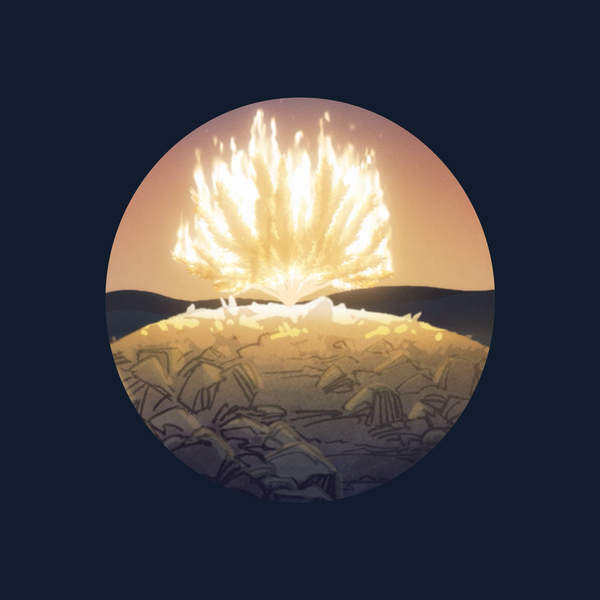
Back to the Tree of Life
Episode Chapters
Show Notes
Quote
God sent one who went into exile and death, just as we all do, because we’ve eaten from the wrong tree. He did not. But he went to that fate anyway, so that he could break through the other side, overcome the serpent, and open the way back to the tree of life.
Key Takeaways
- Jesus often uses garden imagery to talk about the coming Kingdom of God and our response to it.
- Jesus goes further than this when he describes himself as the tree and people as the branches who become extensions of his life.
- The final pages of the Bible describe the promise of a future tree of life in a new Eden.
The Stories That Raised Jesus
In part one (0-16:00), Tim and Jon summarize the series up until now. The theme of trees in the Bible is about whether we will live and rule with God or seize autonomy for ourselves. These two choices are represented by the tree of life and the tree of knowing good and bad. Throughout the Hebrew Scriptures, we often find humanity facing moments of testing before a tree on a high place, just like the first humans. Failure leads to death and exile, while success is often marked by building an altar and sacrifice. God promises that one day a seed of the woman will become an offering by overcoming evil at its source while also being destroyed by it. This theme of tests and sacrifices carries on throughout the narrative in the lives of key characters.
- Noah makes a sacrifice of thanks and atonement after the flood, and God accepts it.
- Abraham obeys God’s test to sacrifice his son, and God brings a substitute instead.
- Moses offers himself as a sacrifice, and God forgives the people.
- Isaiah points forward to the ultimate servant, who will conquer evil by being conquered by it. King David creates an image of Eden in the high city of Jerusalem with the temple at the center. God promises to bless David’s family, yet Israel’s history is filled with generations who raise up false Edens on high places. Isaiah calls this out, yet he promises that one day God will bring a holy seed who will become the suffering, exalted servant who will plant God’s people as a new Eden. Tim shares that Jesus was raised on this literature. As early as the birth narratives, Jesus is portrayed as the holy seed in the womb of Mary. When Jesus later comes onto the scene, he declares that the reign and rule of God is coming on earth and he is the one bringing it. As he heals and liberates people from bondage, he is ushering in a new Eden. Jesus often described the coming of this new Kingdom by using parables.
Gardens In The Parables Of Jesus
In part two (16:00-32:30), Tim shares several examples of Jesus’ garden parables from Matthew 13. Jesus tells a famous story about a farmer scattering seed across four kinds of soil. Jesus equates the seed to the message of the Kingdom. Some people refuse it, some have no room for it, and others receive it. Jon asks about an image used at the end of the parable of the sower. Tim quotes from two scholars about the yield brought by the seed. Tim quotes from R. T. France.
The fact that the singular seed sown in good soil is subdivided into three different levels of yield suggests that we’re intended to notice the variety. Disciples are not all the same. Equally genuine disciples will produce different levels of crop depending on different gifts and circumstances. A similar point is made in the parable of the talents. Tim also quotes from Leon Morris. These three groups—a hundred, sixty, and thirty—commentators throughout history have disagreed as to what these figures are, whether they are an exaggeration to talk about the bountiful nature of the crop, or whether they are to be taken more literally, assuming some sort of knowledge of agriculture. Without knowing the seed, it’s impossible to be dogmatic. Maize, for example, might well produce a hundred or more seeds, though with wheat, that’s not so likely. Tim and Jon also discuss the parable of the wheat and weeds growing together and the parable of the mustard seed. Jon points out that Jesus doesn’t seem to be doing anything novel. He’s reading the Hebrew Scriptures and sharing how God is bringing Eden blessing to the world. The first set of parables in Matthew map onto the Sermon on the Mount, illuminating one another. As we follow the life of Jesus and trust him, our lives and our world will begin to reflect the garden of Eden.
Jesus As The Tree Of Life
In part three (32:30-36:15), Tim shares that Jesus goes further than just showing Eden as a way of life. Instead, Jesus calls himself the tree and people the branches (John 15:5). Those who trust in Jesus become like trees of life themselves and find their source of life in him. God is growing a new garden; Jesus is the source, and people are the trees. Instead of sprouting out of good soil, we sprout out of Jesus himself.
The Future Tree Of Life
In part four (36:15-end) Jesus announces the arrival of a new Eden, but the last pages of the Bible show its culmination. One of the promises that Jesus gives in the opening of the book of Revelation is, “To him who overcomes, I will grant to eat of the tree of life which is in the paradise of God” (Revelation 2:7). “Paradise” is borrowed from the Persian word for garden. The tree of life in a new Eden is a future promise for the people of God. This eternal life begins with Jesus and culminates on the last pages. “This is eternal life, that they may know you, the only true God, and Jesus Christ whom you have sent” (John 17:3). Tim and Jon read through several passages at the end of Revelation to talk about how this new Eden is described.
Revelation 21:1-3
Then I saw a new heaven and a new earth, for the first heaven and the first earth passed away, and there is no longer any sea. And I saw the holy city, new Jerusalem, coming down out of heaven from God, made ready as a bride adorned for her husband. And I heard a loud voice from the throne, saying, “Behold, the tabernacle of God is among men, and he will dwell among them, and they shall be his people, and God himself will be among them.
Revelation 21:10-11
And he carried me away in the Spirit to a great and high mountain, and showed me the holy city, Jerusalem, coming down out of heaven from God, having the glory of God. Her brilliance was like a very costly stone, as a stone of crystal-clear jasper.
Revelation 22:1-2
Then he showed me a river of the water of life, clear as crystal, coming from the throne of God and of the Lamb, in the middle of its street. On either side of the river was the tree of life, bearing twelve kinds of fruit, yielding its fruit every month; and the leaves of the tree were for the healing of the nations.
Revelation 22:13-14
“I am the Alpha and the Omega, the first and the last, the beginning and the end.” Blessed are those who wash their robes, so that they may have the right to the tree of life, and may enter by the gates into the city. Our next episode will center on how we get from Jesus’ announcement of this new Kingdom to the reality of it. The answer comes as Jesus faces his own test by a tree on a high place.
Scripture References
Referenced Resources
Check out Tim's library here. You can experience our entire library of resources in the BibleProject app, available for Android and iOS.
Show Credits
Defender Instrumental by Tents Our Tree of Life video. Show produced by Dan Gummel. Powered and distributed by Simplecast.

